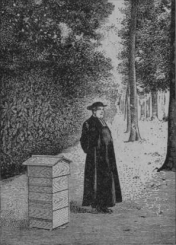
Warré plans
Warré methods
Warré modifications
Warré precursors
Groups / Fora
Google
e-group
Biobees.com
forum
Abbé Warré's book
Beekeeping for All:
Pressing comb for harvesting honey (and wax)
Warré describes how to recover honey from comb by draining on page 115 of Beekeeping For All. However, there is often quite a lot of honey left in the comb after draining. As the comb contains brood cells and thus silk from cocoons, there are two options for removing the residual honey, namely feeding it back to the bees or pressing.
The whole traditional honey harvesting process from selecting the combs to cold pressing the honey to rendering the wax by hot pressing can be seen in the videos of Georg Klindworth's 600-skep commercial beekeeping operation in Germany (see note 1).
The more that the honey is exposed to air during extraction, the greater the risk of its subtle aroma and flavour components being lost and, as honey is hygroscopic, water being absorbed from the atmosphere. Also the increased exposure to oxygen in the air in the process could bring deterioration by chemical changes. In regard to these factors, draining under gravity is already an improvement over centrifugation in an extractor. But, better still, pressing combs in a closed system helps provides honey that has encountered minimal exposure to the air. This honey is better able to maintain qualities that are lost with most extractors, open presses and straining systems. Also, honey pressed in a closed system has a lower tendency towards crystallization.
Closed system pressing, on its own, does not guarantee a high quality of honey. One must also ensure that honey does not ever flow in thin or long streams in its journey from cell to jar. Honey that has been protected from exposure to the air can retain its flavour components, volatile organic compounds and other essences.
Here we describe four ways of pressing which differ in their cost, complexity and degree of protection of the honey from air, starting with a fully closed system:
1. Enterprise sausage stuffer.
2. Templeton (Stade) press (its use for hot pressing of wax from comb is also
described).
3. Fruit-type presses sold for use with honeycomb.
4. Inexpensive home-made horizontal and vertical presses based on car scissor jacks.
1. The Enterprise sausage stuffer
We thank Bill Wood for contributing photos of this press and details of its application to honeycomb.
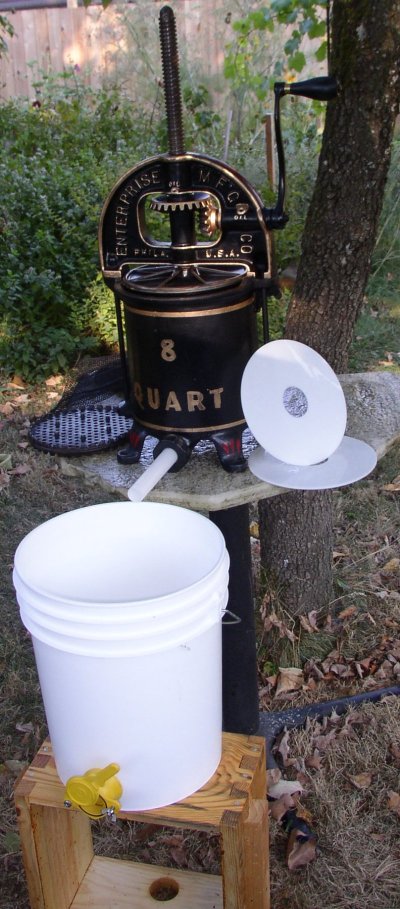 The Enterprise sausage press is a closed system press in cast-iron that
works very well for pressing honey from full comb. The Enterprise presses are powerful
hand-crank early American sausage presses and can still be readily found in North America
as used items at a reasonable price. These presses, as new items, are currently
manufactured by Chop-Rite and are not inexpensive.
There are numerous other varieties of piston type sausage presses available in North
America and other parts of the world, that are appropriate for pressing honeycomb. See
note 2 for links to stainless steel sausage presses.
The Enterprise sausage press is a closed system press in cast-iron that
works very well for pressing honey from full comb. The Enterprise presses are powerful
hand-crank early American sausage presses and can still be readily found in North America
as used items at a reasonable price. These presses, as new items, are currently
manufactured by Chop-Rite and are not inexpensive.
There are numerous other varieties of piston type sausage presses available in North
America and other parts of the world, that are appropriate for pressing honeycomb. See
note 2 for links to stainless steel sausage presses.
The photo on the left and the enlargements below show the Enterprise with the piston retracted, the filter plate (left), two gaskets (right) and the ripener or settling/bottling tank (below). The filter plate is a heavy steel plate having many +/- ¼ inch perforations. It has +/- ¼ inch stand-offs and a serrated rim top and bottom. Though this is called a filter, in pressing honey, its main value seems to be that of providing clearance or flow space for the honey to more freely find the exit spout.
Use of the Enterprise press: first place the strainer plate in the bottom of the tub and then add the honeycomb in a nylon mesh bag (see note 3). Press the comb. It is more difficult to press the last portion of the load. At some point just give the crank a turn and wait for a minute between subsequent turns. At the end, pull out the bag, remove the cake of wax, and repeat the process by pressing another load into my settling (ripener) tank. Each 8 quart pressing takes about 20 minutes.
The mesh bag is the only filter results in an almost complete absence of wax or other particles in the resultant honey.
During first attempts with this press, honey crept upwards around the poor seal between the edge of the large plunger plate and the sides of the tub. But using an UHMW gasket (see note 4), the 'blow by' leakage of honey was remedied. The use of two of these gaskets, stacked between the mesh bag of honeycomb and the large plunger plate is recommended.
It is very easy to clean all of the press components, of honey and wax. After the pressing operation, the components are coated with a thin film of food grade mineral oil for storage. Before re-use, the oil is wiped from the honey contact surfaces with a clean cloth. There is a very thin film left and there may be better sealants to protect the metal during storage and to protect the honey during processing.
The exposure of the honey to air could be further reduced with a food grade plastic tube leading into the ripener through a hole in its lid.
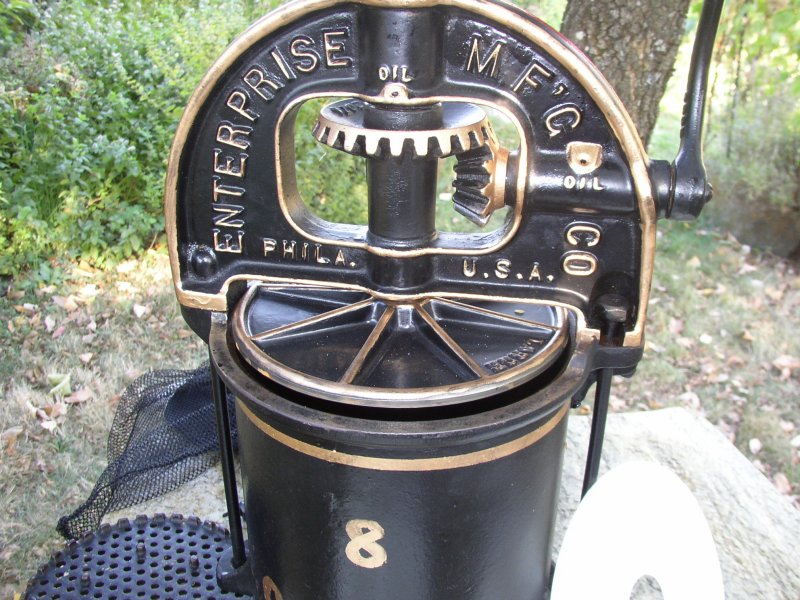
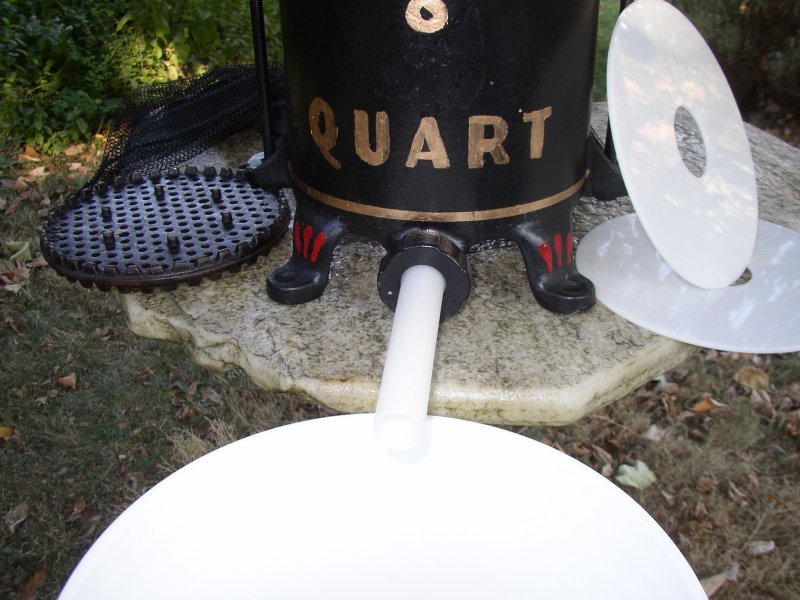
2. Templeton (Stade) press for recovering honey and wax
This press is based on the one used at Georg Klindworth's 600-hive traditional skep beekeeping operation near the Luneberg heath in Germany. The Templeton is updated from the old Stade design.
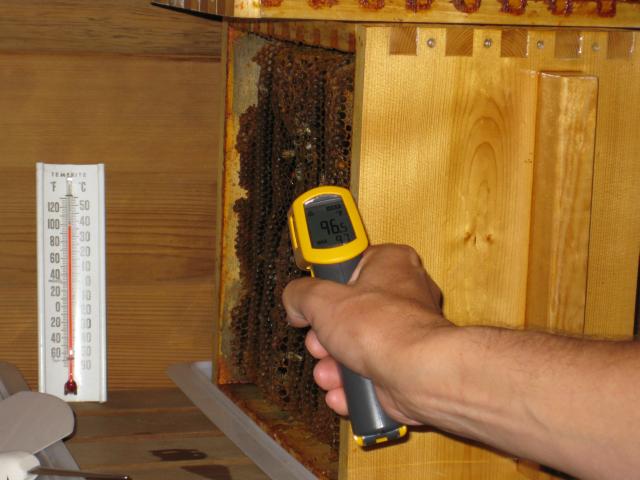
Above: Warré boxes of honeycomb are pre-warmed (35C).
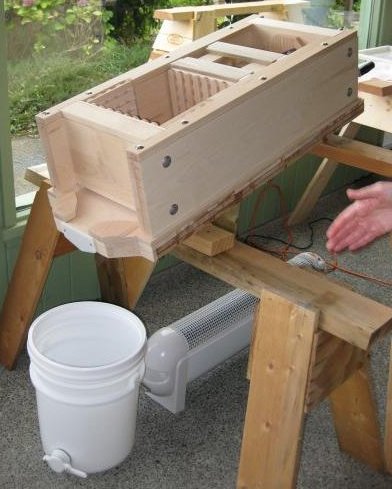
Above: the Templeton (Stade) press set on a sloping support with heater and ripener (settling tank) in position. The press is constructed from hard white maple which is widely used for food contact e.g. chopping blocks. Marine plywood is incorporated elsewhere for strength, and there's a little high density polyethylene for sliding members and the press face-diverter, but the honey touches mostly only maple.
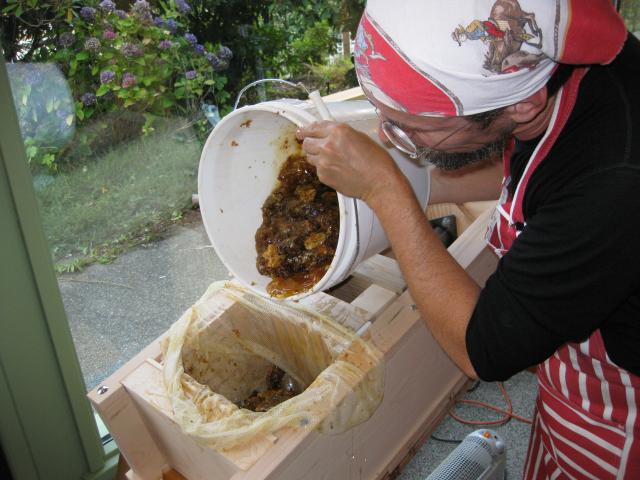
Above: pouring mashed honeycomb into the straining bag in the pressing chamber.
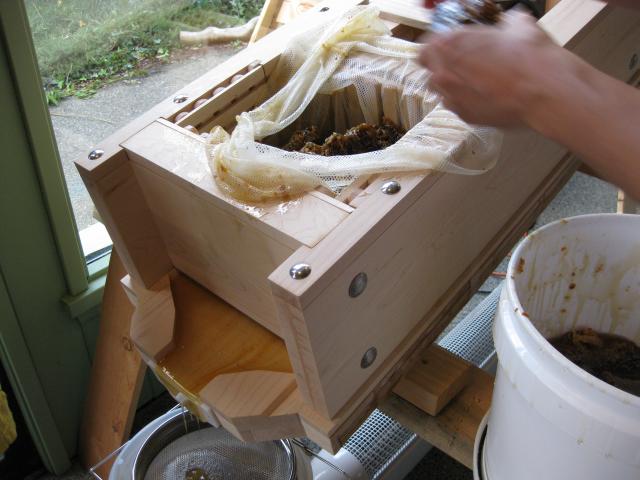
Above: filling the pressing bag. Note finer strainer in position on ripener.
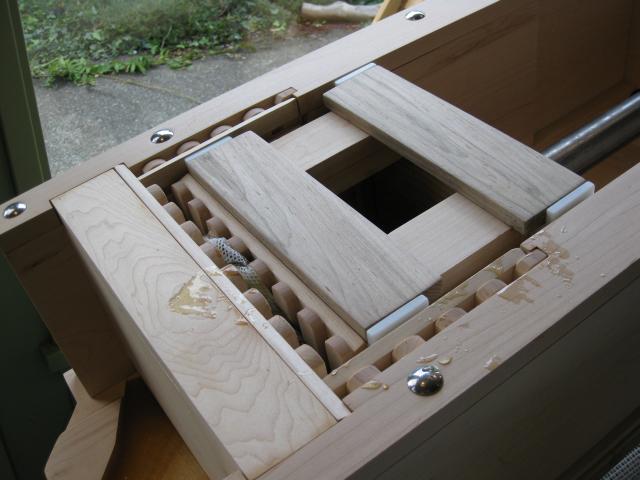
Above: pressing the bagged mash.
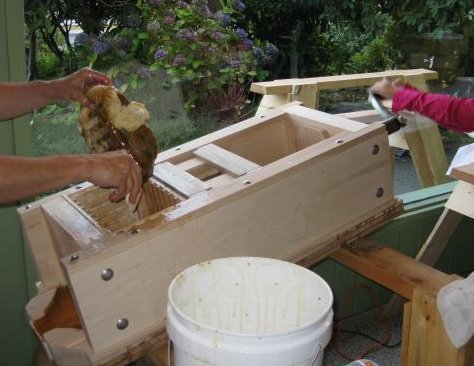
Above: turning the crank to open the press after pressing, and removing the wax cake.
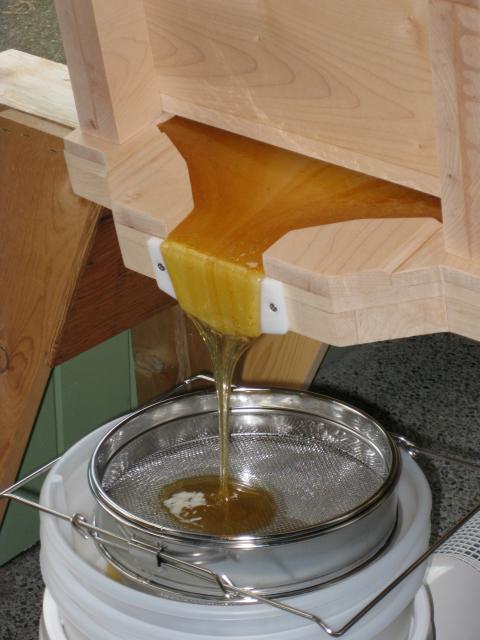
Above: straining the honey emerging from the press.
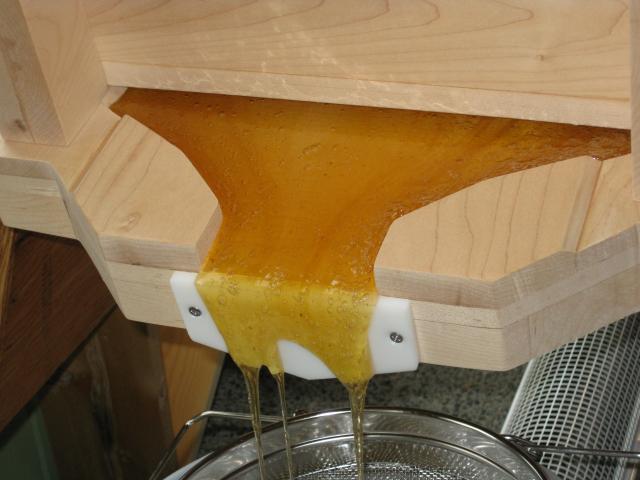
Above: close-up of outlet showing flow guides.
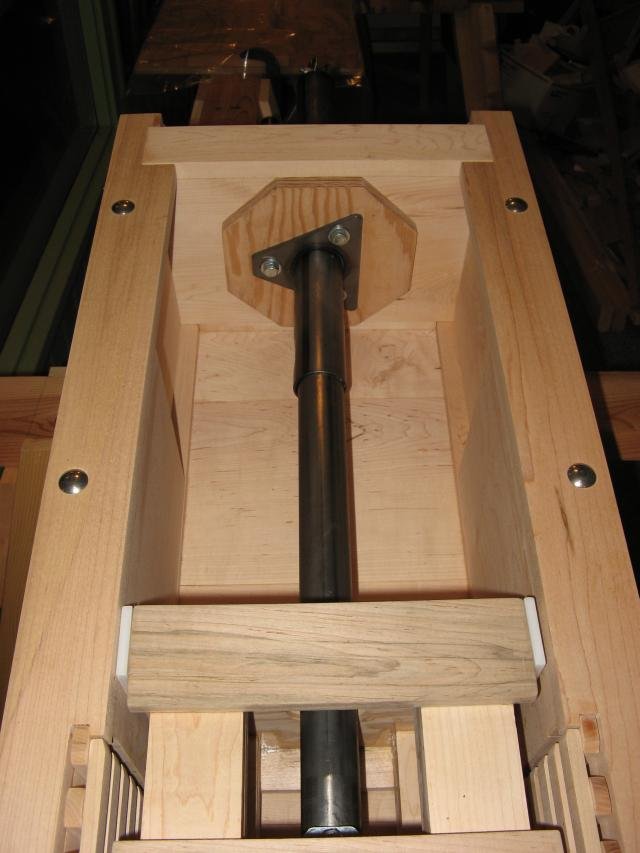
Above: Detail of the drive shaft. The press screw itself is an acme-type screw, fully shrouded for hygiene and safety, with internal load bearings. Tip: lubricate with edible mineral oil/beeswax mix.
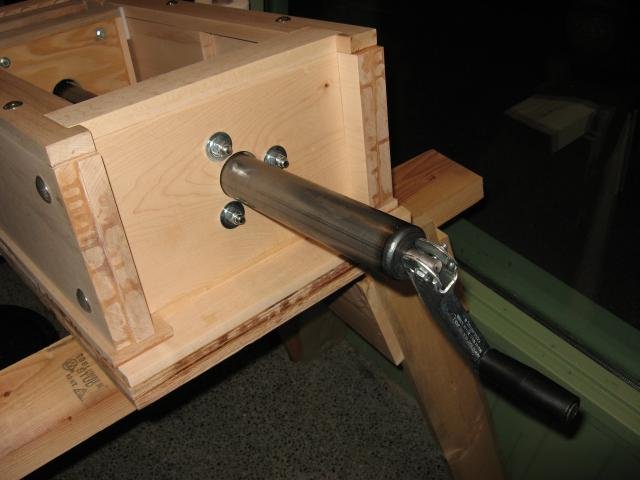
Above: The crank handle was borrowed from a discarded car jack; The plan is to replace it later with a largish wheel for rapid spinning for faster unloaded press movement.
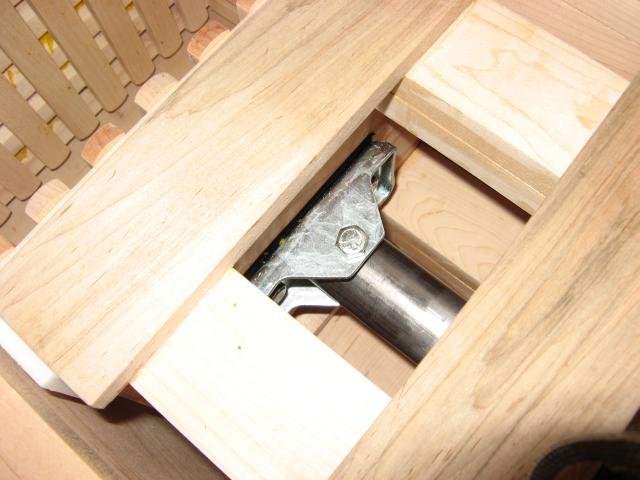
Above: Interface from screw to piston.
This press can also be used for rendering wax from the pressed comb cake. The wax pressing went as follows:
1) Rinse/soak remnant honey from honey-pressing wax in tepid water, breaking wax into smallish chunks. Take swill from rinsing and use to wash interior of new-wood hive boxes and top bars; trying to make them smell better for bait hives etc.
2) Dump rinsed wax into an enameled-steel canner, fill with hot water and bring to 70C/160F over a low heat. Stir now and then. Do not let it boil. No open flames. An electric stove and hot plate is suitable.
3) Place heavy-duty nylon pressing sack (see note 5) into the press maw. This is the same kind of sack used for honey pressing, but once it's been used for wax, it is no longer suitable for honey pressing. Short of major solvents, there is simply no way to get all the wax out.
4) Sluice the hot pressings with hot water into the sack. Wax and water are immediately run into the catch bucket, which has no strainer because it would have to be heated to >65C to prevent clogging. Repeat until the sack is full or most of the melted comb has been skimmed off.
5) Twist the sack firmly and lodge neck to either platen or piston side of action. Advance the piston until resistance increases to stoppage, or you fear the sack might burst. Squirting of hot wax was not a problem, but the sack was not completely full. Prudence suggests a cover over the press top.
6) Retract the piston. Dislodge the sack from the press grid(s). Loosen/crumble the wax. Pour more hot water over it. Re-twist the sack and press again. By the second pressing, most of the wax is gone.
7) Remove the pressed sack, which should contain now mostly cocoons and other rubbish. Dump into your compost pile for the worms. It would probably attract wax moths.
The biggest challenge is having enough hot (but not boiling) water on hand for repeated rinsing and melting wax off tools etc. At Georg Klindworth's farm they have a large cauldron.
Wear heavy rubber gloves reserved for wax rendering only and an apron. Take care with scalding water and molten wax Drop cloths on the floor around the pressing area. Finally, some haste is called for so things do not seize up with cooled wax.
The crude wax is then set aside to settle and cool, after which it's simply loosened & lifted off the dirty water.
See this press in Action:
http://www.youtube.com/watch?v=gnu0UGxnJWA
(honey)
http://www.youtube.com/watch?v=maTcxjhkB4w
(wax)
Plans are available at: http://sketchup.google.com -- to access the Sketchup model search for "Templeton-Stade Honey & Wax Press".
3. Fruit-type presses sold for use with honeycomb
Most good beekeeping suppliers stock honey presses that can also be used for fruit. Two examples are shown here.
The first is often sold as a 'heather press'. It has a stainless steel cylinder, but the bowl is coated mild steel. Versions with stainless steel for all parts that contact the honey exist. The bottom of the screw in this press sits in a metal plate with a hollow in it. The plate is bolted to the wooden piston. With this arrangement, the piston can tilt and jam in the bore, especially if the honeycomb is enclosed in a cloth bag.
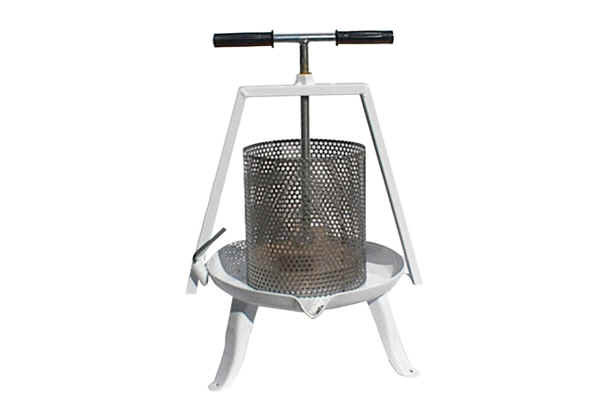
Illustrated below is the same concept only in stainless steel. The photo shows Tim Malfroy (New South Wales) pressing Warré combs. The press was supplied by Sweinty and can hold most of the combs from a Warré box. It comes with a cloth liner but pressing is quicker without it. With the piston obviously firmly fixed to the screw, tilting and jamming of the piston, a design defect in the press illustrated above, is avoided. More photos from this operation are shown at https://www.milkwood.net/2012/03/26/new-press-for-crushing-wild-honeycomb/ .
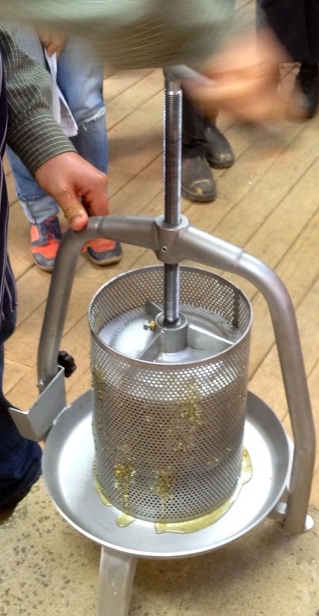
Various makes of fruit presses based on the same principle as above have wooden slats instead of a perforated stainless steel cylinder. Many beekeeping suppliers on the European continent offer these for use with honey. An example of one is shown below (photos Bil Harley).
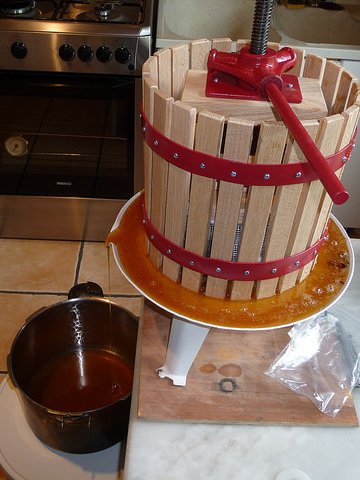
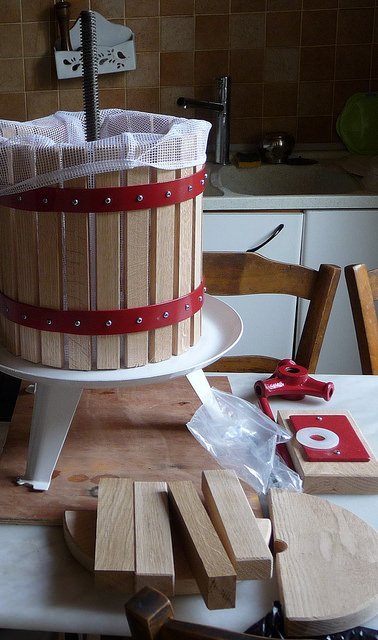
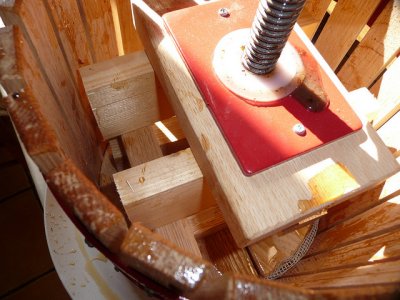
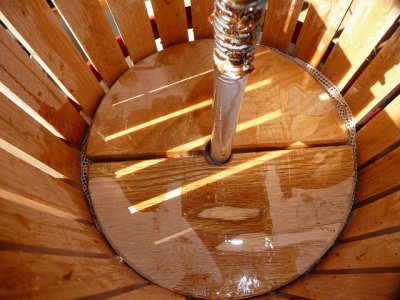
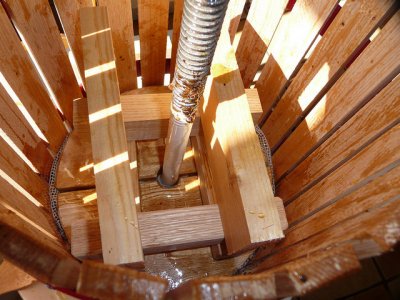
4. Inexpensive home-made horizontal and vertical presses based on car scissor jacks
Vertical operation
The following image shows the Mk1 version of Norman Weston's home made press based on a car scissor jack and a stainless steel saucepan.
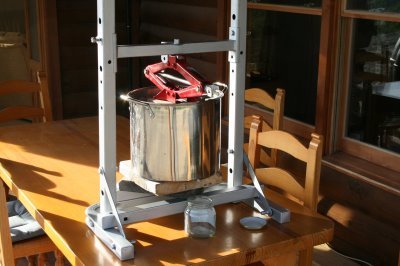
For more pictures and a description see his blog at:
http://normsbeesnaturally.blogspot.com/2009/03/home-made-honeycomb-press.html
For its application to honeycomb see:
http://normsbeesnaturally.blogspot.com/2009/03/first-test-of-home-made-honey-press.html
Horizontal operation
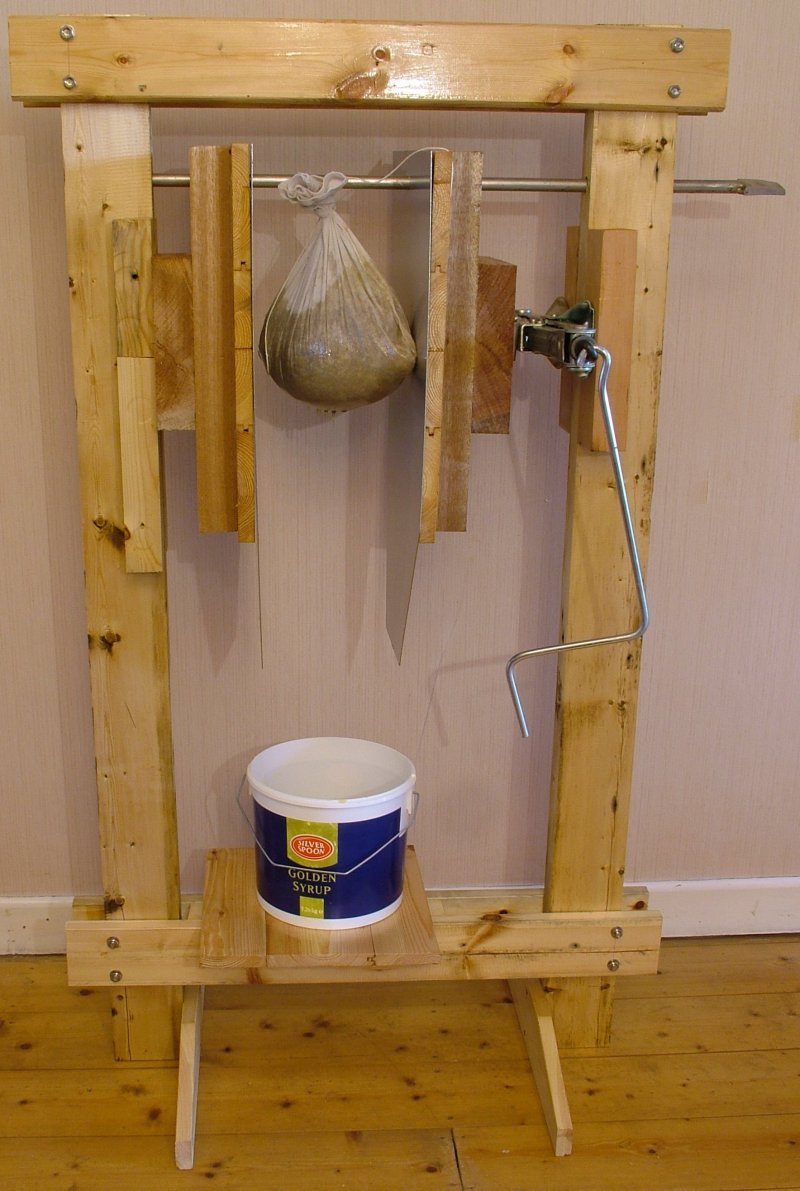
This was built by David Heaf after James D. Satterfield's design except that the honey contact plates are made of stainless steel. For more photos and construction details see:
http://www.dheaf.plus.com/warrebeekeeping/pressing_honey.htm
Notes
1. Skep beekeeping videos in which methods of pressing honey and wax are shown. Although only two of the videos concern pressing all six are listed here as they are richly instructive regarding beekeeping with the swarm impulse.
Since writing this page it has come to our attention that the International Scientific Films Archive in Göttingen, which offered these videos at its web site www.iwf.de, has gone into liquidation. However, they have been transferred to the German National Library of Science And Technology. The result is that at the time of updating this page (15 April 2015) only some parts of the film are previewable in English on their site: https://av.getinfo.de/search?153&q=Klindworth .
However, the videos appear (and disappear) from time to time on YouTube: At the time of updating this page (21 July 2021) they are accessible at the following URLs:
Spring work
https://www.youtube.com/watch?v=k2IjNBbLESY
Swarm preparations
https://www.youtube.com/watch?v=k9dl_8tKqBo
Prime swarming
https://www.youtube.com/watch?v=NaHo1q2SPO8
Cast swarms
https://www.youtube.com/watch?v=Q_ZPozOEaHg
Summer work
https://www.youtube.com/watch?v=dXA0JTOzlj8
Autumn work
https://www.youtube.com/watch?v=pozwoU0FKuM
Honey pressing
https://www.youtube.com/watch?v=yIfhM0kNr5o
Wax pressing
https://www.youtube.com/watch?v=ambkAIFNgYM
All sections are available as a single 2 1/2 hour video:
https://www.youtube.com/watch?v=hn5OxMXCSz8
2. Several stainless steel sausage stuffers of various capacities and quality are listed on the Internet. See for example: http://www.suitesupply.com/vertical-sausage-stuffer-20.pgt-072001w.01.htm
3. Note on Bill Wood's application of the Enterprise sausage stuffer: the mesh bag came from a scuba diving store. Types of nylon shrimp bags, locker bags, laundry bags, cheese bags, brewers' hops strainer bags may serve well. A large, 1/8 to 1/4 inch, mesh is preferable.
4. A UHMW (Ultra-High Molecular Weight) polyethylene, also known as high-density polyethylene (HDPE) gasket may be made at home or seen here. The gaskets are thin. They are from 1/8-inch material and could possibly be formed at home. They are a round plate in shape, but they should have a large hole for one to grab them with a hook to extract them from the bottom of the press. Of importance is that they fit snugly against in the bore of the press to prevent blow-by at that perimeter. With the Enterprise / Chop-Rite presses, a steel pressure or plunge plate is driven downwards through the steel cylinder which holds the mass of honeycomb. The plate and cylinder are not machined with close tolerances to achieve a tight fit. The diameter of the plate is perhaps 1/8 inch less than the internal diameter of the cylinder bore. Hence, during pressing, honey can well up around the edge of the plate. In initial trials the honey that flowed up between the plate and cylinder bore, covered the plate with ½ an inch or so of honey. This was found to be messy and somewhat wasteful and unsanitary/unhygienic. One of these gaskets was purchased on eBay below and it provided a vast improvement. Another was purchased and, using the two of them stacked together, almost no upward leakage of honey was found. More modern presses claim tight seals and probably require no further gaskets. With the Enterprise / Chop-Rite presses, a gasket or two is recommended.
5. Nylon pressing sack, like those at http://www.canningsupply.com/product/Nylon_Pressing_Bags/strainers_juicers